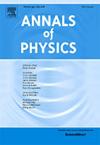Heat engine efficiency and thermodynamical fluctuations of quantum Oppenheimer–Snyder anti-de Sitter spacetime
IF 3
3区 物理与天体物理
Q2 PHYSICS, MULTIDISCIPLINARY
引用次数: 0
Abstract
This research paper conducts a comprehensive analysis of the thermodynamic features of quantum Oppenheimer–Snyder-AdS black holes, highlighting the effects of Joule–Thomson expansion and higher-order thermal fluctuations. We examine the metric function to investigate the crucial influence of the quantum factor on the determination of the event horizon radius and the overall spacetime geometry. An extensive analysis of the Joule–Thomson coefficients elucidates the intricate gas dynamics near black holes, revealing specific cooling and heating regions. Our findings emphasize the significance of isenthalpic curves in comprehending the energy dynamics related to these occurrences. Furthermore, we examine important thermodynamic functions, like corrected entropy, enthalpy, Helmholtz and Gibbs free energies, internal energy and specific heat capacity. Our examination of corrected entropy demonstrates significant peaks and troughs relative to the radius of the event horizon, substantiating the complex correlation between black hole mass and quantum parameter. The Helmholtz free energy demonstrates considerable oscillations affected by the quantum parameter, but the internal energy indicates enormous energy buildup with an increase in horizon radius. Significant variations in enthalpy and Gibbs free energy are also observed, signifying changes in thermodynamic stability when mass and quantum parameters fluctuate. The specific heat analysis reveals intricate oscillations, indicating critical phase transitions and the thermodynamic stability of the system. These findings underscore the imperative of including quantum effects in black hole thermodynamics, therefore deepening our comprehension of the intricate connection between quantum physics and gravitational events.
热机效率和量子奥本海默-斯奈德反德西特时空的热力学波动
本文全面分析了量子Oppenheimer-Snyder-AdS黑洞的热力学特征,重点研究了焦耳-汤姆逊膨胀和高阶热涨落的影响。我们考察了度量函数,以探讨量子因子对确定视界半径和整体时空几何的关键影响。对焦耳-汤姆逊系数的广泛分析阐明了黑洞附近复杂的气体动力学,揭示了特定的冷却和加热区域。我们的发现强调了等焓曲线在理解与这些事件相关的能量动力学中的重要性。此外,我们还研究了重要的热力学函数,如校正熵、焓、亥姆霍兹和吉布斯自由能、内能和比热容。我们对修正熵的检查表明,相对于视界半径,黑洞质量和量子参数之间存在显著的波峰和波谷,证实了黑洞质量和量子参数之间的复杂相关性。亥姆霍兹自由能受量子参数的影响表现出相当大的振荡,但内能表明随着视界半径的增加能量大量积累。还观察到焓和吉布斯自由能的显著变化,表明当质量和量子参数波动时热力学稳定性的变化。比热分析揭示了复杂的振荡,表明了临界相变和系统的热力学稳定性。这些发现强调了将量子效应纳入黑洞热力学的必要性,从而加深了我们对量子物理和引力事件之间复杂联系的理解。
本文章由计算机程序翻译,如有差异,请以英文原文为准。
求助全文
约1分钟内获得全文
求助全文
来源期刊

Annals of Physics
物理-物理:综合
CiteScore
5.30
自引率
3.30%
发文量
211
审稿时长
47 days
期刊介绍:
Annals of Physics presents original work in all areas of basic theoretic physics research. Ideas are developed and fully explored, and thorough treatment is given to first principles and ultimate applications. Annals of Physics emphasizes clarity and intelligibility in the articles it publishes, thus making them as accessible as possible. Readers familiar with recent developments in the field are provided with sufficient detail and background to follow the arguments and understand their significance.
The Editors of the journal cover all fields of theoretical physics. Articles published in the journal are typically longer than 20 pages.
 求助内容:
求助内容: 应助结果提醒方式:
应助结果提醒方式:


